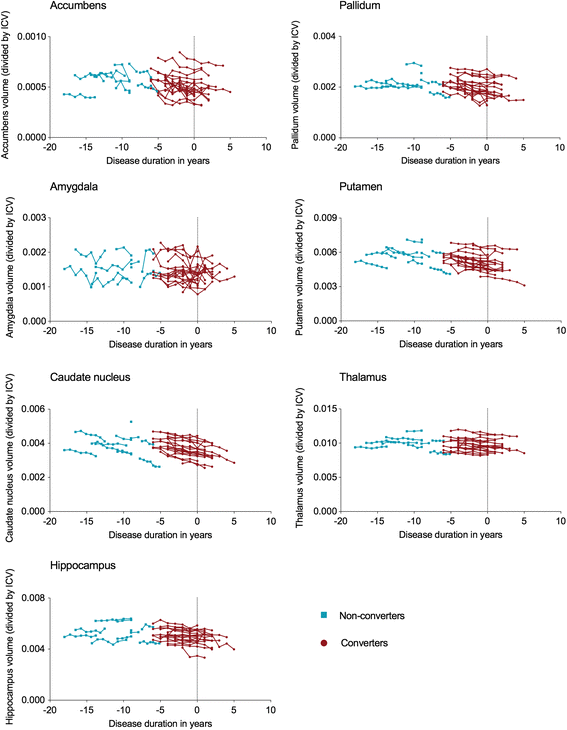Atrophy of the putamen at time of clinical motor onset in Huntington's disease: a 6-year follow-up study
- PMID: 29593880
- PMCID: PMC5866517
- DOI: 10.1186/s40734-018-0069-3
Atrophy of the putamen at time of clinical motor onset in Huntington's disease: a 6-year follow-up study
Abstract
Background: Striatal atrophy is detectable many years before the predicted onset of motor symptoms in premanifest Huntington's disease (HD). However, the extent of these neurodegenerative changes at the actual time of conversion from premanifest to a motor manifest disease stage is not known. With this study, we aimed to assess differences in degree and rate of atrophy between converters, i.e. premanifest individuals who develop clinically manifest HD over the course of the study, and non-converters.
Methods: Structural T1-weighted Magnetic Resonance Imaging (MRI) scans were used to measure volumes of seven subcortical structures. Images were acquired yearly over a maximum follow-up period of 6 years (mean 4.8 ± 1.8 years) in 57 participants (healthy controls n = 28, premanifest HD gene carriers n = 29). Of the premanifest HD gene carriers, 20 individuals clinically developed manifest HD over the course of the study, i.e. converters, whereas 9 individuals did not show any clinical signs. Differences between controls, converters and non-converters in volumetric decline over time were assessed using a one-way ANCOVA with age, gender and intracranial volume as covariates. All data were adjusted for multiple comparisons using Bonferonni correction.
Results: The putamen showed a significant difference in volume at the time of conversion in the converters group compared to the non-converters group (adjusted p = 0.04). Although, volumes of all other subcortical structures were smaller at time of conversion compared to non-converters and controls, these differences were not statistically significant. Over time, rate of volumetric decline in all subcortical structures in converters did not significantly differ from non-converters.
Conclusions: Putamen volume is smaller at the time of manifestation of motor symptoms compared with premanifest HD that not showed any clinical disease progression during the course of this 6-year follow-up study.
Keywords: Converters; Huntington’s disease; Longitudinal study; Motor onset; Putamen; Structural MRI.
Conflict of interest statement
The local Medical Ethical Committee approved this study and written informed consent was obtained from all participants included in this study.Not applicable.Emma M. Coppen and Jeroen van der Grond report no competing interest. Raymund A.C. Roos receives grants from TEVA Pharmaceuticals, Cure Huntington’s Disease Initiative (CHDI), Gossweiler Foundation, and is member of the advisory board of UniQure.Springer Nature remains neutral with regard to jurisdictional claims in published maps and institutional affiliations.
Figures

References
-
- Tabrizi SJ, Langbehn DR, Leavitt BR, Roos RAC, Durr A, Craufurd D, et al. Biological and clinical manifestations of Huntington’s disease in the longitudinal TRACK-HD study: cross-sectional analysis of baseline data. Lancet Neurol. 2009;8(9):791–801. doi: 10.1016/S1474-4422(09)70170-X. - DOI - PMC - PubMed
LinkOut - more resources
Full Text Sources
Other Literature Sources

